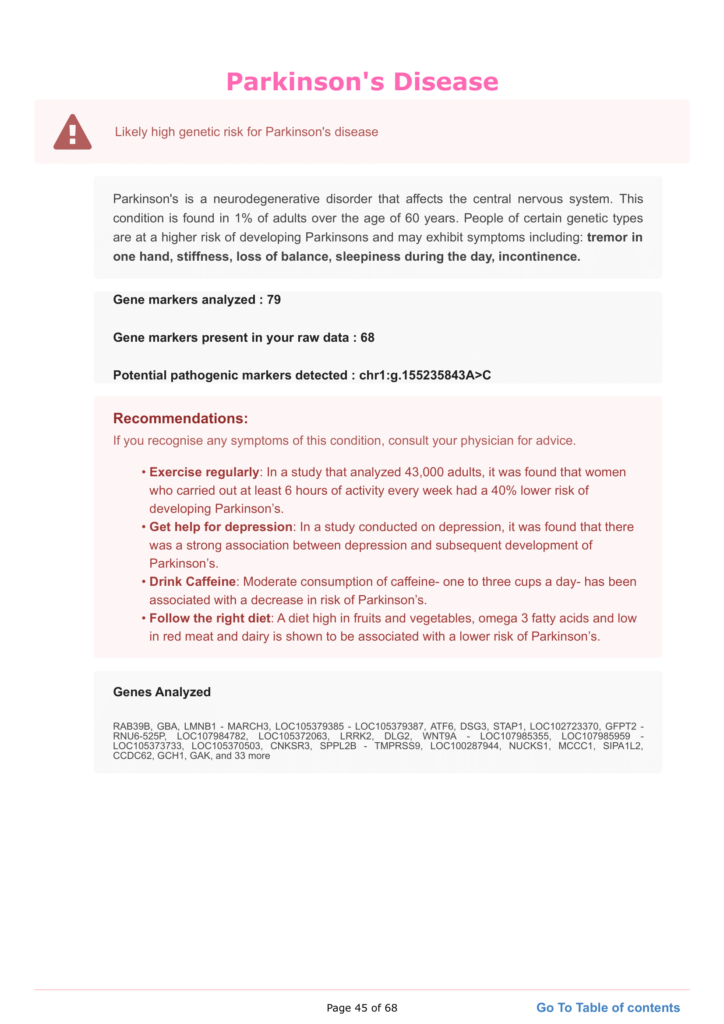Xcode Life's Parkinson’s DNA Report
Researchers have identified several genes associated with Parkinson’s disease.
In the sample report below, we've attempted to analyze some essential genes that increase the risk for Parkinson’s.
You can identify your genetic risk of Parkinson’s by using your 23andMe DNA data and placing an order for the Gene Health Report.
Alt text: Lewy Body Dementia and Parkinson’s - Xcode Life’s Parkinson’s Genetic Report
What is Parkinson’s?
Parkinson’s disease is a brain disorder that causes uncontrollable and unintended movements like shaking, stiffness, and difficulty balancing and coordinating.
It is a neurodegenerative disorder due to the degeneration of dopamine-producing nerve cells (neurons).
Dopamine is a common brain chemical or neurotransmitter responsible for nerve signal transmission.
Parkinson’s affects one in every 500 people.
Most people who develop symptoms of Parkinson’s are usually over 50.
People assigned male at birth (MAB) are likelier to develop Parkinson’s than those assigned female at birth (FAB).
Causes, Symptoms, and Types of Parkinson’s
Causes
When the nerve cells in the basal ganglia (part of the brain that controls movement) are damaged, they produce less dopamine than usual.
Lesser than usual dopamine results in movement-related problems that are characteristic of Parkinson’s.
Though the mechanism behind Parkinson’s is fairly known, what causes the degeneration or death of the neurons is unknown.
People with Parkinson’s also lose nerve endings that produce another neurotransmitter called norepinephrine. This chemical controls functions like heart rate and blood pressure.
Lower than usual level of norepinephrine gives rise to other Parkinson’s symptoms like:
- Fatigue
- Irregular blood pressure
- Decreased movement of food within the digestive tract
- Sudden drop of blood pressure when the individual suddenly sits up or stands from a lying position
Symptoms
Common symptoms of Parkinson’s disease include:
- A tremor in hands, arms, legs, jaw, and head
- Stiffness of muscles during which they remain contracted for a long time
- Slow movements
- Poor balance and coordination, increasing the risk of falls
- Depression and other emotional effects
- Difficulty in swallowing, speaking, and chewing
- Skin issues
- Urinary problems
- Constipation
The symptoms of Parkinson’s are different in people, and the rate at which they progress also differs among individuals.
While early symptoms of the condition are subtle, they aggravate as the disease progresses.
Family members are often the first to notice changes in people who develop symptoms of Parkinson’s.
Types of Parkinson’s
Several types of Parkinson’s disease exist. The three most common ones are:
- Idiopathic Parkinson’s
- Vascular Parkinsonism
- Drug-induced Parkinsonism
What Is Lewy Body Dementia (LBD)?
According to the Alzheimer’s Association, 50% to 80% of people with Parkinson’s disease will develop dementia.
Several brain cells of people with Parkinson’s contain unusual clumps of the protein alpha-synuclein. These cells are called Lewy bodies.
Researchers are still trying to understand the normal and abnormal functions of the alpha-synuclein protein and its effect on dementia.
Some existing research states that Lewdy bodies play a role in many conditions that cause dementia.
Lewy body dementia is a condition that occurs when Lewy bodies build up in the brain, eventually damaging the brain cells and causing dementia.
It is challenging to diagnose Lewy body dementia as its symptoms are easily confused with those of other brain disorders and psychiatric conditions.
Lewy Body Dementia and Parkinson’s - Parkinson’s Disease Dementia (PDD)
Lewy body dementia (LBD) is of two types.
In both these types, the underlying changes occurring in the brain over time in people give rise to similar symptoms.
- Parkinson’s Disease Dementia (PDD)
Cognitive symptoms develop more than a year after the movement symptoms like tremors and muscle stiffness set in.
PDD starts as a movement disorder with symptoms like slowed movements, shuffling walks, muscle stiffness, and tremors.
Cognitive symptoms of dementia and mood and behavioral changes may set in later.
It is important to note that not all individuals with Parkinson’s develop dementia, and it is difficult to predict who will.
Some older patients with Parkinson’s may develop some degree of dementia.
- Dementia with Lewy Bodies (DLB)
Cognitive symptoms in people with DLB develop within a year of the movement of symptoms.
People with DLB also show a decline in their thinking ability, making it look similar to Alzheimer’s.
However, they also develop movement issues and other symptoms of LBD with time.
Summary
- Parkinson’s disease is a neurodegenerative disorder that results in uncontrollable and unintended body movements like shaking and tremors.
- Common Parkinson’s symptoms include tremors in the hands and legs, muscle stiffness, poor balance and coordination, and depression.
- The three most common Parkinsonism are– Idiopathic, Vascular, and Drug-Induced.
- Several brain cells in people with Parkinson’s contain clumps of the alpha-synuclein protein called Lewy bodies.
- Research states that Lewy bodies play a role in developing dementia in various brain disorders, including Parkinson’s.
- Lewy Body Dementia (LBD) is of two types– Parkinson’s Disease Dementia (PDD) and Dementia with Lewy Bodies (DLB).
References
- https://www.apdaparkinson.org/article/understanding-parkinsons-disease-dementia-lewy-bodies/
- https://www.nia.nih.gov/health/what-lewy-body-dementia-causes-symptoms-and-treatments
- https://www.hopkinsmedicine.org/health/conditions-and-diseases/dementia/dementia-with-lewy-bodies
- https://www.medicalnewstoday.com/articles/lewy-body-parkinsons/
- https://www.nhs.uk/conditions/parkinsons-disease/
- https://www.nia.nih.gov/health/parkinsons-disease
- https://www.parkinson.org/understanding-parkinsons/what-is-parkinsons





